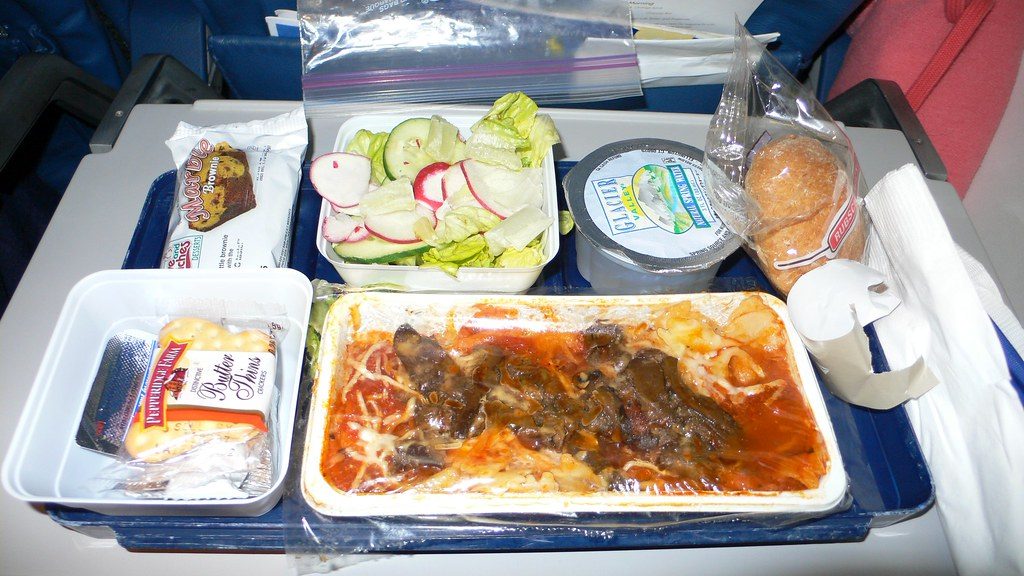Do you have a favourite food? Perhaps you love Pizzas, Chinese or Indian food. Perhaps you enjoy roast or served fresh seafood that would keep you happy.
Whatever is your favourite, an airline version of is never quite up to scratch. No matter how much you love a full English breakfast, a ‘fry-up’ served in a plastic tray with a sip of orange juice in a carton and a little packet of disposable cutlery and wipes might not quite touch the sides.
But why does airline food seem to be so poor? Why are train food trolleys so expensive? How come cruise ships manage to serve up great food? We’re here to answer all of those questions, so join us on our virtual travels…
Food from the trolley
Meals from the wheels can be pretty poor if you’re buying off the trolley. Unless you’re travelling in first class, crisps and biscuits and dry sandwiches are about all you can expect from train travel. And that’s if you’re lucky (or unlucky, depending on your view), as many services have axed their on-board trolley services.
Apparently, the reason being for scaling down or removing the on-board trolley service is quoted to be due to a lack of sustainability, but it seems that real reason is the lack of business. There’s simply no reason to pay so much for a sandwich or packet of crisps on-board the train when the same, if not better, food exists a throwing distance from the train at a slightly lower price. Train stations are filled to the brim with all kinds of outlets, and it’s not just Burger King and WHSmith on offer now. For many of us, it’s no trouble to pack our own food and bring that with us or grab something on the way to the platform.
If you travel via first class, you can enjoy a selection of snack and drinks, and potentially a complimentary menu on some days. But as the Telegraph posits, the array of food often doesn’t come to much, and when you consider the price difference between a standard and a first-class ticket, you’re technically paying for the food you’re eating and then some. In fact, The Tab’s Annie Lord tried to make a profit from her £49.00 first-class ticket via eating and drinking the complementary food. Two polystyrene cups of hot drinks, six gin and tonics, one apple juice, one Pepsi, one cake, one bag of nuts, a bag of crisps, a piece of fruit, a salad, and a few snacks later, Annie made a profit of £5.65. A victory?
Food on the water
Travelling across sea isn’t as popular as flying, so perhaps that’s why we don’t hear many poor reviews of boat travel food. Or perhaps it is because space isn’t so much an issue on a ferry as it is on a plane or train — you tend to find a good array of restaurants and food services on a ferry. The quality isn’t so much an issue as the price, with many advocating taking your own food with you in order to avoid the ever-present expense of travel-based food.
Food in the air
Now, we come to the real problem. , indeed, the questionable meat floating in a generic gravy waiting to be poked at with the disposable cutlery provided.
It’s very questionable that we can somehow sent messages to the other side of the world within a blink of an eye, but we can’t cook good meals in the sky yet. We’ve not only sent men to the moon, we presumably fed them on the way there and back. How hard can it really be?
Thought, despite how bad the food can be, you can give them credit considering they’re being cooked in such a cramped space which must be difficult to contend with. The largest independent airline food provider makes 685,000 meals every day, says The Guardian, giving a whole new meaning to ‘fast food’. So it’s not that airlines don’t have the capacity to serve pomegranate-glazed lamb or chilled prawns with an aioli tarragon sauce. In fact, back in the 1950s, before the dawn of flight classes, meals were ridiculously flashy, with charcuteries featuring in the aisles of the then-smaller planes.
It later came about that airlines had to charge the same for the same route. So then it occurred to airline businesses that they could split flight classes and offer this lovely grub to the first class flyers, and less-expensive food (or none at all) to economy class. Even with technology like sous-vide allowing for food to be vacuum-sealed and slow-cooked to keep it tasty even when cooked in the air, technological advancements in airline food don’t often filter down to economy class plates.
Really, the matter of airline food quality is a selling point. The huge variation between economy class food and first class is designed to encourage people to want to pay more and upgrade their seat. For those with frequent flyer points, many choose to spend their points on seat upgrades rather than a free ticket, and as Business Insider notes, a flight costs an airline more than fancy food does.
In conclusion, airline food doesn’t need to be, nor is it really awful. . You just need to pay a lot more to get a ticket for a spacious seat and a larger drink than those tiny cans of single-mouthful Colas.
Sources:
https://www.wired.co.uk/article/best-airline-food-airplane-gate-gourmet
https://www.cuisinesolutions.com/about-sous-vide/
https://www.theguardian.com/lifeandstyle/wordofmouth/2011/jul/04/airline-food-flights-of-fancy
https://www.telegraph.co.uk/travel/comment/first-class-train-carriages-in-the-uk/
https://www.theguardian.com/lifeandstyle/wordofmouth/2011/jul/11/food-to-rail-against



